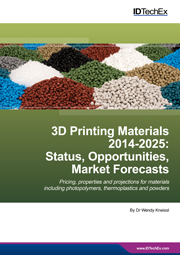IDTechEx forecasts, in its new report “3D Printing Materials 2014-2025: Status, Opportunities, Market Forecasts”, a market value of $615m in 2025. Our analysis shows that the market will not reach a fully competitive state by 2025, meaning that suppliers will continue to charge premiums on their materials. However, should a fully competitive market environment emerge then we forecast that the market value in 2025 will only be $244m. The report provides detailed market forecasts by value and mass, broken down by material types (inkjet material, metal powder, powder thermoplastic, solid thermoplastic and photopolymers).

Price maintenance
Premium pricing is being maintained by some 3D printer manufacturers by the practice of locking end-users into their own materials supplies through key coding and RFID tagging under the guise of “quality control”.
Whilst hard data concerning pricing is hard to come by, some end-users have revealed both the practice and the prices, some of which are hundreds of times the commodity price for similar materials. Further, prices are being maintained at a high level long after R&D costs have been recouped.
This anti-competitive behaviour is preventing the development of an efficient, competitive market for 3D printing materials and is presenting very high barriers to entry for new suppliers. Perhaps most importantly of all – it is hindering the development of new materials for 3D printing. The new IDTechEx report discusses these issues and more.
Price maintenance would see the total market for 3D printing materials reach nearly $600m by 2017 – the largest segment of which is the market for photopolymers, closely followed by thermoplastics in solid (ie. filament or pellet) form. However, this scenario is unsustainable as new printer manufacturers are established and larger end-users exert downwards price pressure on the materials market.
A good 3D printable material
Achieving the desired mechanical, thermal and chemical resistance properties of a 3D printed object is a complex interplay between process parameters and feedstock material properties for any 3D printing technology. End-users want to 3D print with the materials they are used to and want the final properties to match those possible with traditional manufacturing methods such as injection moulding. However this is no easy task.
“3D Printing Materials 2014-2025: Status, Opportunities, Market Forecasts” discusses, on a material-by-material basis, the complexities of developing new formations for 3D printing. It also covers some of the on-going research into materials which are not yet commercially available. A SWOT analysis is provided for each material type in the context of end-user needs, assessed via extensive in-depth interviews across a range of sectors.
The future markets
The report details forecasts from 2013 to 2025 in the context of realistic adjustments to both prices and the breakdown of the installed base by technology type.
In 2013 we see the total volume of 3D printing materials being produced reaching 1,980 tons. Figure 1 below shows how this total will be divided between the different materials studied.
Fig 1. Division of the total volume of materials production in 2013.
Source: IDTechEx report “3D Printing Materials 2014-2025: Status, Opportunities, Market Forecasts”
Looking ahead to 2025, photopolymers will remain the largest single market for 3D printing materials. However this market will lose ground and the highest compound annual growth rates will be seen in the markets for metal and plastic powders currently produced at around 30 and 40 tons per year respectively.
Key to growth for any individual 3D printer manufacturer on the materials front is to gain in share of installed base. This would be a much more effective strategy for increasing revenues from materials than to increase or maintain material prices.
Market data
IDTechEx has carried out a detailed and systematic study of multiple scenarios, taking into account the effects of price, installed base, competitive environment and other market drivers. Included are:
• Market forecasts by value and mass for 3D printing materials between 2013 and 2025.
• Market forecasts broken down by the following technologies:
– inkjet materials
– metal powder
– thermoplastic (powder)
– thermoplastic (solid)
– photopolymers
For more details see “3D Printing Materials 2014-2025: Status, Opportunities, Market Forecasts” (www.IDTechEx.com/3Dmats).
IDTechEx will be hosting a business-focused conference and masterclass on the topic, see “3D Printing LIVE!” (www.IDTechEx.com/3Dprinting).
Advertisement
Learn more about IDTechEx





